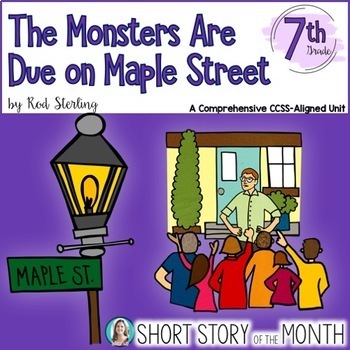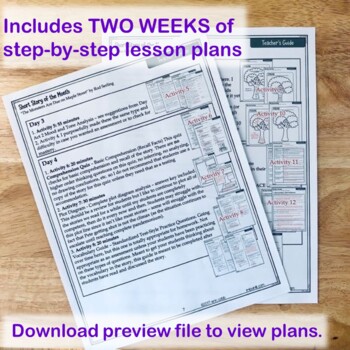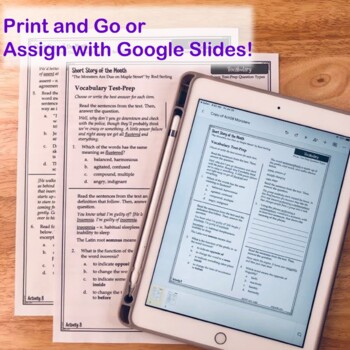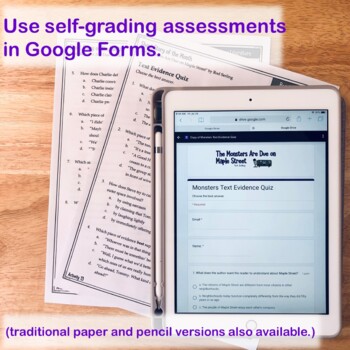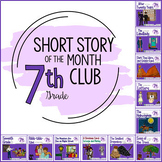The Monsters Are Due on Maple Street Teleplay Short Story Unit Grade 7
- Zip
What educators are saying
Also included in
- Short Story of the Month Club, Grade 7Grab this collection of popular Short Story Units tailored for Grade 7! I created these units specifically around the CCSS for grade 7, but they can absolutely be used in grades 6-10 - please check the preview file to verify this. Try the first month (August!) fPrice $49.95Original Price $96.39Save $46.44
Description
The Monsters are Due on Maple Street by Rod Serling (Twilight Zone) Teleplay Unit
This is the Short Story of the Month Club, Grade 7: October Selection – Click here to read more about the Short Story of the Month Club!
Skills Focus:
Mood & Tone
Theme
Elements of Plot
Conflict
Finding Text Evidence
Comparing Multiple Versions in Multiple Formats
Vocabulary Practice Standardized Test Format
Identifying Supporting Details (Informational Text)
Listening Comprehension
See the list of activities below for a COMPLETE list of all of the skills covered. The ones above are simply the FOCUS of this unit.
Editable and digital versions included! Scroll to the bottom for details.
This is a comprehensive, Common Core-Aligned Unit packed with a ton of rigorous resources for teaching with this short story (teleplay). I’ve also included within the unit instructions for accessing this short story if you don’t have it.
It would take me forever to explain to you just how uniquely amazing this resource is, so go ahead and see for yourself. Download and view the unit for another short story, Seventh Grade, for free here. I've also included complete instructions and standards alignments in the preview file so you can look as closely as you like at this unit before purchase.
List of Activities & Difficulty Level: *Easy **Moderate ***Challenge
1: Mood & Tone Quick Notes Lesson*
2: Mood & Tone Printable Practice**
3: Journal Prompt*
4: First Read: Act 1 Mood/Tone Analysis**
5: First Read: Act 2 Mood/Tone Analysis**
6: Literal Comprehension Quiz**
7: Plot Diagram Analysis* *
8: Vocabulary Guide Test-Prep Style***
9: Theme Lesson w/Quick Notes*
10: Monsters Theme Analysis w/Reread***
11: Conflict Analysis**
12: Questions for Text Evidence (ACE)**
13: Text Evidence Quiz***
14: Comprehension Skills Test**
15: Movie Analysis Step 1: Surface-Level**
16: Movie Analysis Step 2: Below the Surface***
17: Nonfiction Article Cold Read Analysis***
18: “War of the Worlds” Listening Guide**
19: Essential Question***
**Digital components included!** All student pages are also included in Google Slides version so that students can access them and complete them digitally. Both assessments (quiz and test) are included in self-grading Google Forms versions.
*EDITABLE* I have added my own original files in PowerPoint format for you to edit if you wish for your own classroom use. This only includes story-specific printables and I can't guarantee your ability to edit them based on your computer's settings and your tech knowledge. Bonus activities that have been included here as a courtesy to you (like interactive notebook lessons) will not include the editable versions - those editable versions are only available in the original resources.
*UPDATE 10/3/19: Modified assessment added as a separate file download folder.
Other 7th grade short story units available:
FREE! August Selection – Seventh Grade by Gary Soto
1. September Selection – Rikki Tikki Tavi: Focus on Four Types of Conflict, Character Motivation, Figurative Language, Sound Devices (onomatopoeia, alliteration, assonance, consonance) and Rhyme Schemes, Citing Text Evidence, Plot Structure (Review), Movie-to-Story Comparison Analysis (RL.7.7)
3. November Selection – "A Christmas Carol" - drama version: Focus: Elements of a Drama, Trace the Development of Theme, Connotation vs. Denotation, Conflict: Man vs. Supernatural, Provide an Objective Summary, Compare Historical vs. Fictional Accounts, and more!
4. December Selection – The Smallest Dragonboy Focus:*Text Evidence* Heavy Text Evidence Practice in this unit; Indirect Characterization, Character Traits, Types of Characters (protagonist, antagonist, round, flat, dynamic, static, sympathetic, minor), Analyzing Contrasting Points of View, Theme, Text Evidence w/Theme
5. January Selection – Song of the Trees Focus: Historical Fiction Analysis, specifically RL.7.9, Genres of Fiction, Imagery, Text Evidence (includes PARCC-style text evidence quiz), Development of Theme Analysis, Poetry Analysis of I, Too, Sing America by Langston Hughes and Caged Bird by Maya Angelou, Nonfiction Skills - analysis of Jim Crow Laws
6. February Selection – “The Highwayman” by Alfred Noyes
Poetry Analysis, including: Sound Devices, Rhymes, Rhyme Schemes, Rhythm, Plot Analysis, Effects of Rhythm, Rhyme, and Sound Devices on Poem and/or Stanzas, Figurative Language. Also includes Close Reading/Annotation Guide, plus Complete 7-page Question-Answer flow. See individual item listing's preview file for samples.
7. March Selection – The Lottery by Shirley Jackson
Focus: Irony, Symbolism, Allegory, Text Evidence, Implied Meaning
8. April Selection – Dark They Were, and Golden Eyed by Ray Bradbury
Focus: Text Evidence, Figurative Language (Vocabulary), Audio Techniques (RL.7.7), Circular Plot Structure, Author's Craft, Imagery, Point of View, Analyze Historical Context
9. May Selection – The Landlady by Roald Dahl
Focus: Text Evidence, Supporting Arguments With Text Evidence, Foreshadowing/Analyzing Author's Craft, Analyzing Word Choice, Mood & Tone
Plus comparing this short story to its short film, radio play, and another poem by the same author
10. June Selection - After Twenty Years by O. Henry
Focus: Characterization, Indirect Characterization, Classifying Characterization Examples, Character's Point of View (heavy on this one), Context Clues, Review of ALL grade 7 literature common core skills!
****Grade 7 Final Assessment for Reading Literature | Final Exam
Short story units available in the Grade 6 collection:
FREE! August Selection – Stray by Cynthia Rylant
1. September Selection – Included – Just Once by Dygard** Focus: Elements of Plot (Plot Pyramid), Responding to Questions for RL.6.5, Realistic Fiction Genre Characteristics, Main Idea & Supporting Details (Informational Text standards, paired text links included)
2. October Selection – The Hitchhiker by Fletcher** Focus: Elements of Drama, Story Devices (foreshadowing, flashback, suspense), Comparing Written, Audio, and Video Versions, Elements of Plot, Analyzing Development of Plot, Finding Text Evidence, Nonfiction Paired Text, Essential Question
3. November Selection – Thank You Ma'am by Langston Hughes Focus: Characterization (Direct and Indirect), Character Traits, Theme, Comparing Similar Themes Among Genres, Finding Text Evidence, Paired Passages - poem by Hughes, memoir by Hughes, and excerpt from biography about Hughes, all with similar themes - Deep Analysis included!
4. December Selection - The Emperor's New Clothes (Folktale unit with other folktales included) Focus: Text Evidence (EXTRA practice on this skill in several different activities), Folktales - Properties of Different Types, including fairytales, tall tales, fables, legends, and myths - at least one of each type of folktale is included within this unit with accompanying activities!; Conflict (Internal vs. External), Figurative Language
**Review of these skills from previous units: theme, character traits, characterization, story elements, plot pyramid**
and BONUS Mid-Year Assessment!
5. January Selection – The Bracelet by Yoshiko Uchida
Focus: Heavy on the informational text in this one! Point of View, Fiction Genres, Characteristics of Historical Fiction, Constructed Response with Vocabulary in Context, ACE Method for Constructed Response Questions, Citing Text Evidence
6. February Selection – The Gold Cadillac by Mildred D. Taylor
Focus: Text Evidence, Character's Point of View, Mood and Tone, Static/Dynamic Characters, ACE Questions, Plot and Theme
7. March Selection – "Casey at the Bat" Narrative Poem
Focus: Text Evidence, Theme Development, Summarizing Stanzas, How does each stanza fit into the narrative poem?; Sound Devices in Poetry (and the effects of), Figurative Language in Poetry
8. April Selection - All Summer in a Day
Focus: Deep Characterization Analysis, Impact of Setting on Mood, Figurative Language Analysis, Text Evidence Activity + Practice Test, Imagery/Sensory Details
9. May Selection – The Jacket by Gary Soto
Focus: Text Evidence, Memoirs, Writing a Memoir, Personification, Deep Figurative Language Analysis, Poetry (Odes), Includes Activities and Comparison for "Ode to Pablo's Tennis Shoes" by Gary Soto
10. June Selection – Charles by Shirley Jackson
Focus: DEEP Theme Analysis, Development of Theme Analysis, Comparing Themes Among Texts/Genres, Text Evidence, Making Inferences, Indirect Characterization Analysis, Analyze Meaning of Phrases

